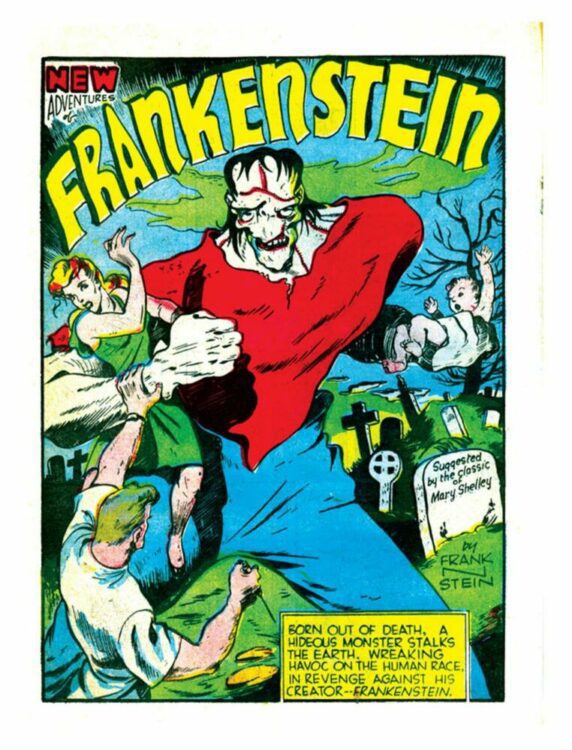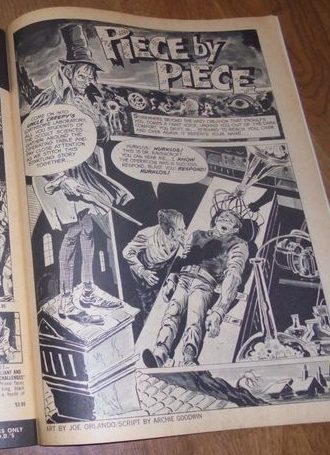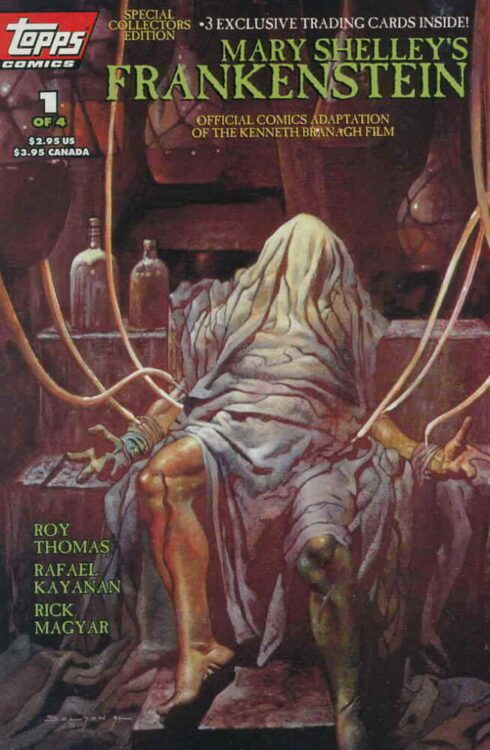The premise is simple: read one comic every day for the entire year. It seems like a simple task but there is no way that I read 365 comics last year, even if you count the individual issues in collections. So, this year, I am committing myself to this reading challenge, in the hope that I can broaden my reading habits and fully engage with my favourite hobby again.
This week is a little different to my usual trawl through the week’s reading. I was lucky enough to give a talk at the Comics Forum 2023 comic conference in Leeds. My talk was based on the visual representations of Frankenstein within a collection of comic book adaptations. In preparation, I obviously read a bunch of comics but instead of going through each one, I thought I would share an edited version of the talk itself. Therefore, I present:
The Constantly Evolving Frankenstein: Changing visual representation through multiple comic book adaptations.
Frankenstein is a great work of literature and has been heralded as the first work of modern Science fiction. It has also become a sprawling transmedia text, spawning theatrical performances, radio plays, film adaptations, experimental performances, and of course, a host of comics ranging from direct adaptations to modern re-tellings. The characters, especially the creature, have been appropriated into other works, such as the robot replica monster created to battle the X-Men in the Marvel comics, and over time there has been an evolution of the narrative and all of the elements associated with Shelley’s original.

Frankenstein or The Modern Prometheus, written by Mary Shelley, was first published in 1818 with a second English edition in 1823. This second edition was prompted by the success of a stage play based on the novel, Presumption: or, the Fate of Frankenstein. This was followed by a single volume third edition, which was published in 1831 and had been heavily edited by the author herself. With a big budget film version released in 1931, and a sequel, The Bride of Frankenstein, following in 1935, there were already a number of versions and adaptations of the novel around when the comic industry turned its attention to the property.
In 1939, DC’s Movie Comics #1 included the first comic book version of the characters, although this itself was an adaptation of the third Universal Frankenstein movie Son of Frankenstein. The images that make up the panels were taken directly from the movie, like a photo-story, with only small elements illustrated to simplify the images for a comic publication. Backgrounds and extras were removed and replaced by flat color fields or large areas of text. This comic reinforces the visual decisions made by the movie director and costume designers, paying Shelley’s original little attention. By this time Boris Karloff’s appearance as the creature had been a marketing phenomenon, with a wide variety of merchandise available. Even today the visuals depicted in the early Universal movies resonate with audiences who may not have seen those films. However, it is not just the creature’s appearance, but sets and elements of the narrative that have become part of mass recognition, detached from the original source.

The influence of previous media can be seen in the first original Frankenstein comic adaptation, Dick Briefer’s New Adventures of Frankenstein, first appearing in 1940’s Prize Comics #1. The comic strip started out as a horror comic, evolved over time into a humour strip but eventually returned to horror in the 1950s. The most interesting aspects of the first issue, a loose adaptation of the novel, are the visual representations of locations and characters but also the acknowledgement of influential sources outside of the novel.
The creature is a large, disfigured, brute with an instantly recognizable flat head and scarred face. The appearance is clearly reflective of Karloff’s appearance in the movie series and the silent anger that features in panels of violence also calls back to James Whale’s 1931 movie. After several pages of seemingly mindless violence, Briefer gives the creature a voice, turning him from the typical ‘grunter’ monster that was part of the mass media adaptation up to that point, into a more thoughtful creature. This final two-panel twist breaks the standard representation of the creature from that time. Frankenstein’s creation was portrayed as a mute, unable to communicate in any way except through violence but Briefer returns some agency to the character, which was a major element of Shelley’s original novel.

Unfortunately this brief recognition of the complexities from Shelley’s book wasn’t to become a feature in the comic book adaptations until much later. Throughout the 1940s and up to the 1970s, further representations of Frankenstein’s creature would reiterate the monstrous aesthetic from the early adaptations. Even when the character is adapted into superhero comics, such as the short lived Dell publication Frankenstein, and Marvel’s The Monster of Frankenstein, the creature is something to be feared — a horrific monster. It is also during this period that the name Frankenstein becomes more closely related to the creature himself and not the creator. In Dell’s superhero comic for example, Frankenstein is the name of the monster and his creator is simply known as The Doctor.
By turning our attention to setting and scenery instead of character, the changes to the novel can be clearly seen. Comics are a visual medium and the metaphors and similes of the novel are translated into imagery and visual symbolism. In issue 30 of Creepy, published by Warren Publishing, the story Piece by Piece written by Archie Goodwin with art by Joe Orlando, starts with a splash page with Uncle Creepy, the narrator, on the left and a ‘mad scientist’ leaving over a body on a table on the right.

Despite Piece by Piece not being an adaptation of Frankenstein directly, the image resonates with the readers. One look at the page and you instantly know what is going on, no background knowledge is required. It is the archetypal ‘mad’ doctor in his lab. From that single image we know that the scientist has built himself a creature from the body parts of the dead and brought him to life via some dangerous scientific means.
This image is instantly recognizable as the creation scene from Frankenstein; however, the lab, the life-giving electricity, and the gothic surroundings are all additions to Shelley’s original novel. The description of Victor Frankenstein’s laboratory and the effect of the events that happen within it help the reader to understand the character and his reactions; however, the design and visualization of the lab has changed drastically across adaptations.
The humble abode where the scientific breakthrough is made barely gets a mention by Shelley. There are not descriptions of elaborate workshops full to the brim of scientific gadgetry or even science fiction machinery and yet a simple Google search for “Frankenstein’s Laboratory” will bring forth a vast array of complex machines, jars and bottles filled with unexplained liquids, just like the scene from Piece by Piece. There is also, always, an abundance of electricity. The ‘spark of being’ that Victor mentions almost in passing in the novel becomes a literal bolt of electricity in a number of adaptations; for example see the Tops adaptation of the film Mary Shelley’s Frankenstein from 1994.

The elaborate lab motif was a very early feature of stage productions, although the comic book versions started out a bit more true to the novel. Classic Comics #26, published in December 1945, was a reductive adaptation of the novel, produced for educational purposes and with the intention of attracting younger readers to classic works of fiction. The writer, Ruth Roche, followed in the footsteps of theatrical performances of the text and edited down or removed large sections of the story while maintaining a fidelity to the original material. Huge sections of the novel have been reduced and presented on a few pages or even in only a handful of panels. Towards the end of page five, the bottom tier shows the studious scientist at work in his lab and just like in the novel, it is an unassuming setting. In the fifth panel, nothing of the background can be seen, instead the image and the text focus entirely on Victor’s obsession. This type of visualization is a technique often applied in comics to draw the reader’s attention to a specific element of the narrative. By removing the background, the reader’s attention is 100% on the character.
Page six creates the atmosphere present in the novel and maintains the normalcy of the rooms without relying on spectacle. There is nothing outlandish in the visuals and the first panel on the page could be any workroom or loft space. Artists Robert Hayward Webb and Ann Brewster are not creating the superhero experience that has become associated with comics in the modern age, instead they are focusing on atmosphere through a sense of realism. The setting is minimal, and only visible as a full room in one panel, but the design and layout allows the artists to engage the reader in the same way that the novel does. Fear, revulsion, and mental imprisonment all coexist on the page.

The design of the laboratory in the Classic Comics version does not embrace the extravagance of other visual adaptations of the novel. One argument against comics being accepted as literature is the visual aspect that they employ and that they favor images over text, but in Roche’s adaptation, the reduction in the plot does not mean a reduction in the meaning. The art takes the signifiers of the novel and gives them visual representations without unnecessary embellishment. In James Whale’s 1931 movie adaptation the scenery is ostentatious and elaborate, mimicking the emphazised horror aspect of the story that Boris Karloff’s creature represents. The movie is about spectacle and was intended to shock its audience. Its success at the box office not only allowed for numerous sequels but it also produced a merchandising frenzy that spread the visual imagery of the movie far and wide. Elements of the movie became part of the zeitgeist and instantly recognizable by the public.
One aspect, the scientist’s lab, has influenced many adaptations and parodies that followed. The influence of the movie can be seen in print as early as 1945 in Dick Briefer’s horror/comedy comic Frankenstein. In the creation sequence, the body of the creature lies atop a large table in the center of a vast stone walled room. The scene is dressed with large electric machines with pipes and cables filling the backgrounds of the panels. The layout leads the viewers eyes down through the page to the creature. In contrast to the Classic Comics adaptation, the attention is given to the creature and the materials/machines used in its birth. The scientist, in Briefer’s version, is the epitome of the mad scientist trope. He is excited and exhilarated by his discovery and not at all despondent or repentant like Victor in the novel. The labs in both Briefer’s comic and Whale’s movie are full of wonder and imagination but also uncertainty. They both embrace the fear of the modern, with machines that can create life as well as bring destruction. Both of these examples embrace a visual excitement not found in Shelley’s novel but has become a mainstay in the history of the adaptations.
One of the most famous sequences of the novel is of the creature’s education. In the middle section of Shelley’s novel, the Creature takes over as narrator and relates to Victor the circumstances surrounding the emergence of his intelligence. “Through this crevice a small room was visible, whitewashed and clean but very bare of furniture,” the creature explains, what lies before him is a restricted and contained view, similar to a static film made with a static camera or a series of comic panels. The images that pass before him act as guides to language and emotion and this is how comics work to tell stories. Writers such as Thierry Groensteen stress the importance of the relationship between different panels and the images that they contain, just as in literature Structuralists concentrate on the meanings of objects and theatre designers place great importance on the mise-en-scene. The Creature’s view through the peephole is reminiscent of a theatre audience staring across the threshold of a stage into the fabricated world unfolding before them. Everything on that stage and in view serves some purpose in informing the reading of the scene and the characters. Transposing this to a comic page, the layout of the page and the decisions regarding stage dressing is just as important as any other visual medium. Where the Son of Frankenstein from Movie Comics #1 failed to successfully set the scene, the Classic Comics version succinctly captures the poor, working family.
In two short pages, Webb and Brewster set up the family dynamic, the Creature’s ability to help unseen, the education that the creature undergoes, and the final horror as the family turn on the Creature in disgust. This is achieved through a strong image and text synergy with the caption boxes detailing the Creature’s broadening mind and the props providing signifiers for the relevant stimulus. The ability to layer the signs and signifiers across visual and textual elements allow the artists to relate the same themes and narrative as the novel but in a compact format.

In Gris Grimly’s Frankenstein, the author tells the Creature’s story through silent, at first, comic panels. This technique allows Grimly to show the emergence of the Creature’s intelligence through the act of visual learning. More so than the Classic Comics approach, the concept of seeing is important to Grimly’s version. Although the Creature features in several panels, the majority of the comic strip is viewed from his point of view. The reader peers through the crack in the boards to spy on the family as they entertain each other. The representation of language at this point is incomprehensible because the Creature himself does not understand it so in turn the reader is denied understanding. The view of the world is also very much from the Creature’s point of view with the introduction of objects that, at first, he doesn’t understand. The backgrounds are simplistic, a few lines to represent the wooden boards of the walls, allowing the focus to be on the characters and these new objects. Each of the small panels contains only what is needed to reflect a single emotion or idea. Minimalism is the key.
In modern adaptations, the main concepts of the novel have become the driving factor of Frankenstein stories rather than the recognizable visuals. Dean Koonz has transformed Frankenstein into a modern day serial killer, harvesting internal organs for transplants in order to prolong his life. In this interpretation, the creator and monster have become one and the same.
Over at Marvel comics, the Punisher was briefly re-branded as Franken-Castle, a revenge-driven killer whose torn body is reassembled to resemble the classic monster appearance. The sense of misjustice the creature in the novel feels is overlaid onto the Punisher’s misguided sense of justice and the narrative allows the comic to draw these comparisons between modern super-vigilante action and Mary Shelley’s examination of nature versus nurture.
Victor LaValle’s Destroyer is a modern take on Frankenstein, positioned more as a sequel than a direct adaptation. It focuses on the relationship between creator and the created, drawing on the legacy of each. It was praised at the time of release for its commentary on race relations, demonstrating how the narrative can be repurposed to fit different agendas. Frankenstein lends itself perfectly to this form of storytelling, where the central character, the creature, is a representation of the other, an outcast, someone who does not fit into society. If handled correctly, this otherness can be used to confront social viewpoints and challenge preserved normality.
But what does the examination of a transmedia text like Frankenstein tell us about a) the text and b) the adaptations? With such a rich range of versions to choose from and compare, it becomes apparent that you can find something to fit into whatever theory of study you wish. There are examples of pure entertainment (Marvel’s version), creator indulgence (Gris Grimly), and educational merit (Classic Comics). The original novel has earned a place in literary history and is often the focus of literary study and the adaptations have become as relevant in their respective media. Each of the comics mentioned here have something to say about the original text and touches on the themes addressed by Mary Shelley. The techniques used by the artists and writers of the comic adaptations are varied, and the visual influences are drawn from different places and mediums, but their goals are aligned: they still show respect for the source material and, through adaptation and the desire to walk the fine line between fidelity and creativity as discussed by writers such as Linda Hutcheon, they attempt to bring the concerns of the original to new, and wider audiences.
(Comic counts for our daily read, numbers 306 – 312: Movie Comics #1, Prize Comics #1, Classics Illustrated No. 26, Gris Grimley’s Frankenstein, Victor LaValle’s Destroyer #1, Creepy #30, and Mary Shelley’s Frankenstein #1. Plus James Whale’s 1931 movie, the original novel (third edition) and a host of other media adaptations)

